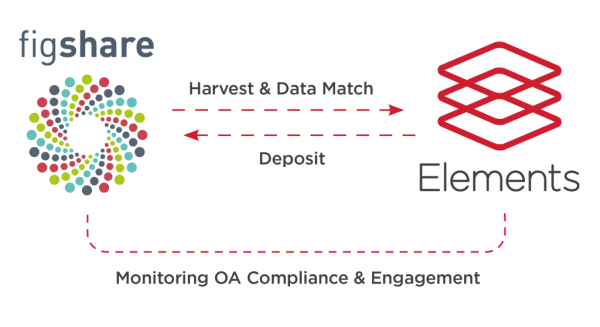As repository technologies evolve alongside the needs of research institutions, the way in which researchers interact with those repositories must also develop. With that in mind, we’ve been working closely with our user community to grow our integrations to help both researchers and their institutions.
The latest integration between Symplectic and Figshare for Institutions establishes a two-way repository integration between the systems, based on Symplectic’s Repository Tools 2 framework.
Repository Tools 2 represents a new approach to repository integrations: Elements positions the repository as a data source, harvesting records to maximise data reuse. This gives Elements a detailed knowledge of the items in the repository which is combined with deposit and monitoring functionality to create a richer and more authoritative repository integration. Symplectic is committed to offering a range of repository integrations, to this end, over the last 12 months, we have launched new integrations with DSpace, EPrints and now Figshare for Institutions using our Repository Tools 2 framework. Figshare can be integrated as a data repository alongside another repository integration or as a standalone repository.
Elements v5.9, released this week, brings together the complementary functionality of Symplectic Elements and Figshare for Institutions to encourage more researchers to make their research openly available, and to contextualise Figshare collections by connecting it with the wider research activities of the institution: another step towards ensuring researchers get credit for all their research.

The first generation
In August 2015, Symplectic released the first integration with Figshare for Institutions which positioned Figshare as a data source for Elements. This integration allowed Elements to automatically harvest records for datasets and other kinds of research outputs deposited in Figshare for Institutions into Elements including direct links to the items in Figshare. This eliminated the need for researchers to re-enter records into another system, and all works harvested from Figshare for Institutions were automatically claimed within Elements on behalf of the researcher.
Since then, we’ve worked with our user community to develop a more flexible, configurable integration, within our Repository Tools 2 framework.
The latest technology
This enhanced integration between the two systems offers multiple new benefits:
- Creates an automated flow of information between the systems, and streamlines deposit workflows.
- Provides multiple pathways to encourage researchers to make their publications openly available, allowing researchers to interact with the system that best fits their workflows.
- Provides sophisticated tools to make it easier for institutions to review and report on OA activities and monitor OA policy compliance.
- Makes figshare records available for reuse in faculty profiles, annual faculty reporting activities, the REF, and a wide range of other activities.
How does it work?
Building on the previous integration, Figshare becomes a customisable data source for Elements, allowing publications, datasets and other outputs to be harvested into Elements where they are automatically claimed for researchers. The harvest functionality ensures the two systems are kept closely in sync, giving Elements an accurate overview of Figshare content and bringing Figshare data into the context of the wider institutional research activities represented in Elements.
The new deposit functionality allows data, publications and other outputs to be deposited to Figshare via Elements. Designed to complement the existing deposit experience in Figshare, this functionality empowers institutions to create multiple OA pathways to encourage researchers to make more of their research outputs openly available on Figshare. Deposits made via Elements become ‘owned’ by the researcher in Figshare as if they were directly deposited there.
By integrating Figshare with Elements, institutions can access specialised open access monitoring and reporting tools. Symplectic’s Open Access Monitor makes it easy to monitor open access engagement and compliance. It offers administrators tools to facilitate deposits into Figshare and provides a range of exports and reports on deposit and compliance. Elements also offers a range of configurable deposit prompts which can be used to further encourage deposits to Figshare. For institutions which use Figshare alongside a papers repository, Elements can be integrated with multiple repositories simultaneously, consolidating deposit and monitoring activities in a single interface.
A range of administration tools makes the integration easy to implement and maintain whilst offering institutions flexibility and control over their data collections. Institutions can customise the integration using a flexible crosswalk framework which gives them control over how to map metadata between the systems.
Figshare for Institutions is a repository where researchers can make their outputs openly available in a citable, shareable and discoverable way. For more information on Figshare for institutions, head over to the figshare site.
Symplectic Elements is a software system used by research institutions to collect, understand and showcase their scholarly activities.